TRENDING
The Most Amazing Ocean Creatures
Published
4 years agoon
The majority of our oceans, to this day, remain largely unexplored. Less than 5% of the earth’s sea floor has actually been mapped. What dwells beneath the surface of these vast bodies of water is an ecosystem filled with diverse creatures so hard to comprehend, they appear alien.
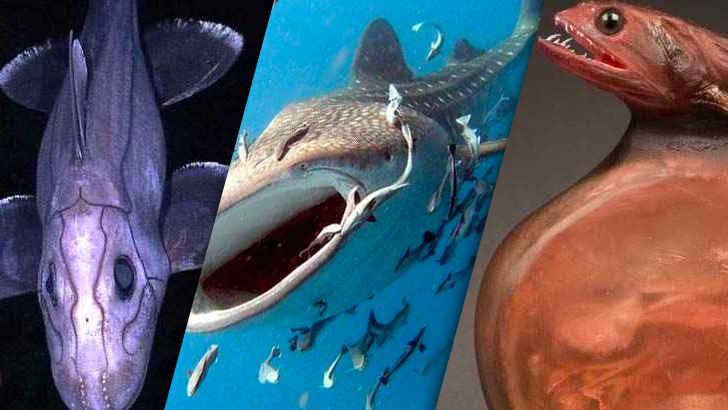 Predatory fish with razor sharp teeth, poisonous squid that emit brilliant colors, and massive whales that can weigh more than 40,000 lbs, just to name a few. Read ahead to see what really lurks beneath.
Predatory fish with razor sharp teeth, poisonous squid that emit brilliant colors, and massive whales that can weigh more than 40,000 lbs, just to name a few. Read ahead to see what really lurks beneath.
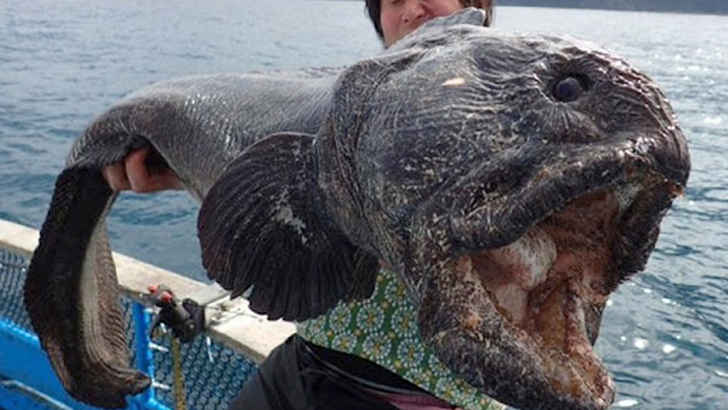 Apart from their iconic appearance, Wolf Fish are unique for the natural antifreeze they produce to keep their blood moving regularly in their very cold habitat. Wolf Fish are an important factor in controlling green crab and sea urchin populations, which can become overly disruptive to habitats if left unchecked.
Apart from their iconic appearance, Wolf Fish are unique for the natural antifreeze they produce to keep their blood moving regularly in their very cold habitat. Wolf Fish are an important factor in controlling green crab and sea urchin populations, which can become overly disruptive to habitats if left unchecked.
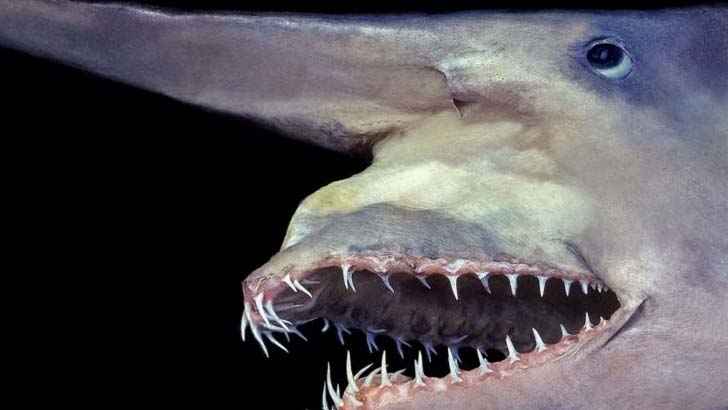 The goblin shark is a rare species of deep-sea shark. Sometimes called a “living fossil”, it is the only extant representative of the family Mitsukurinidae, a species figured to be 125 million years old. This light skinned animal has a distinctive profile with an elongated, flattened snout, and highly protrusible jaws containing prominent nail-like teeth.
The goblin shark is a rare species of deep-sea shark. Sometimes called a “living fossil”, it is the only extant representative of the family Mitsukurinidae, a species figured to be 125 million years old. This light skinned animal has a distinctive profile with an elongated, flattened snout, and highly protrusible jaws containing prominent nail-like teeth.
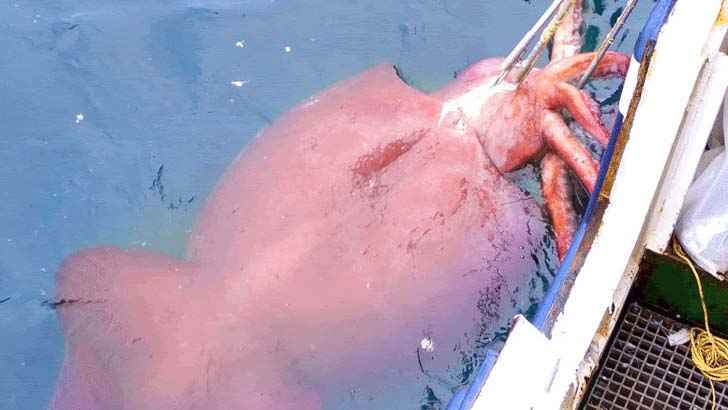 The colossal squid, sometimes called the Antarctic or giant cranch squid, is believed to be the largest squid species. The colossal squid’s limbs are also equipped with sharp hooks, some swivelling, others three-pointed.
The colossal squid, sometimes called the Antarctic or giant cranch squid, is believed to be the largest squid species. The colossal squid’s limbs are also equipped with sharp hooks, some swivelling, others three-pointed.
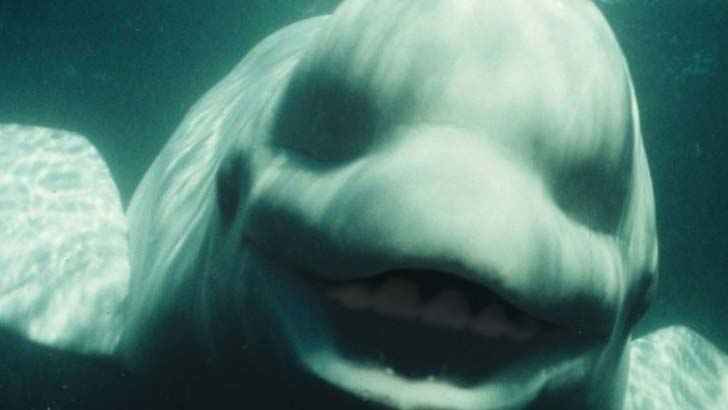 The beluga whale or white whale is an Arctic and sub-Arctic species. This marine mammal is commonly referred to as the sea canary due to its high-pitched twitter. Belugas are gregarious and form groups of up to 10 animals on average, although during the summer, they can gather in the hundreds or even thousands in estuaries and shallow coastal areas.
The beluga whale or white whale is an Arctic and sub-Arctic species. This marine mammal is commonly referred to as the sea canary due to its high-pitched twitter. Belugas are gregarious and form groups of up to 10 animals on average, although during the summer, they can gather in the hundreds or even thousands in estuaries and shallow coastal areas.
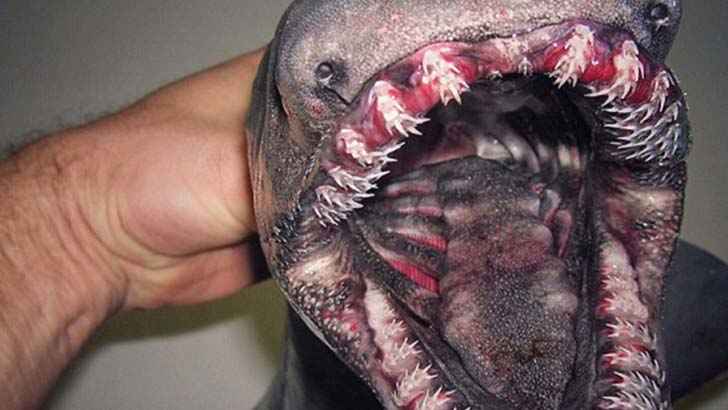 The frilled shark captures its prey by bending its body and lunging forward like a snake. The long, extremely flexible jaws enable it to swallow prey whole, while its many rows of small, needle-like teeth make it near impossible for the prey to escape.
The frilled shark captures its prey by bending its body and lunging forward like a snake. The long, extremely flexible jaws enable it to swallow prey whole, while its many rows of small, needle-like teeth make it near impossible for the prey to escape.
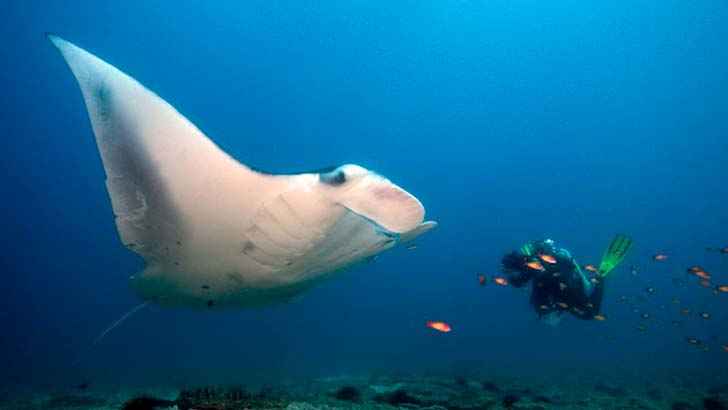 The giant oceanic manta ray can grow to a disc size of up to 23 ft with a weight of about 2,980lbs but average size commonly observed is 15 ft. It is dorsoventrally flattened and has large, triangular pectoral fins on either side of the disc.
The giant oceanic manta ray can grow to a disc size of up to 23 ft with a weight of about 2,980lbs but average size commonly observed is 15 ft. It is dorsoventrally flattened and has large, triangular pectoral fins on either side of the disc.
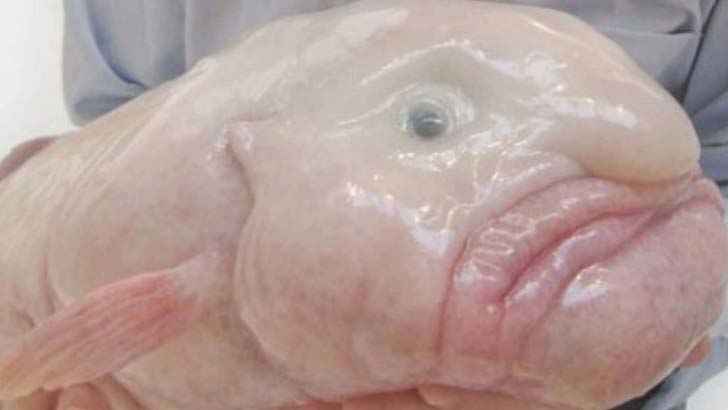 Due to its low-density flesh, the blobfish’s appearance is very different when it is out of water. Its strange and unappealing looks have created much discussion in media outlets. Scientists now fear the blobfish could soon become an endangered species because of deep-ocean trawling.
Due to its low-density flesh, the blobfish’s appearance is very different when it is out of water. Its strange and unappealing looks have created much discussion in media outlets. Scientists now fear the blobfish could soon become an endangered species because of deep-ocean trawling.
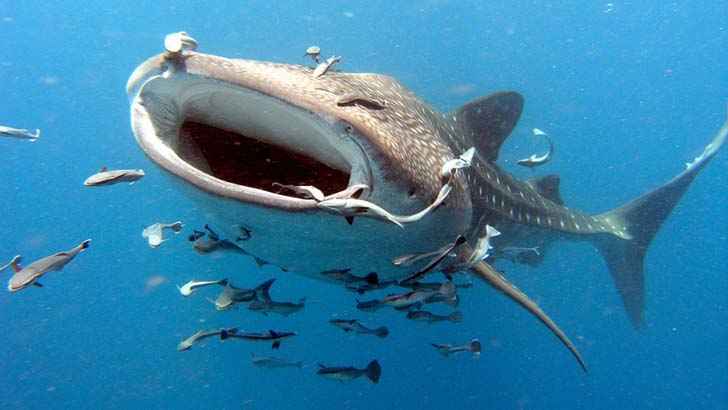 The whale shark is a slow-moving carpet shark and the largest known fish species. The largest confirmed Whale Shark measured in at 41.5 ft and a weight of about 47,000 lbs. Unconfirmed claims of considerably larger Whale Sharks, over 46 ft long and weighing at least 66,000 lbs, are not uncommon.
The whale shark is a slow-moving carpet shark and the largest known fish species. The largest confirmed Whale Shark measured in at 41.5 ft and a weight of about 47,000 lbs. Unconfirmed claims of considerably larger Whale Sharks, over 46 ft long and weighing at least 66,000 lbs, are not uncommon.
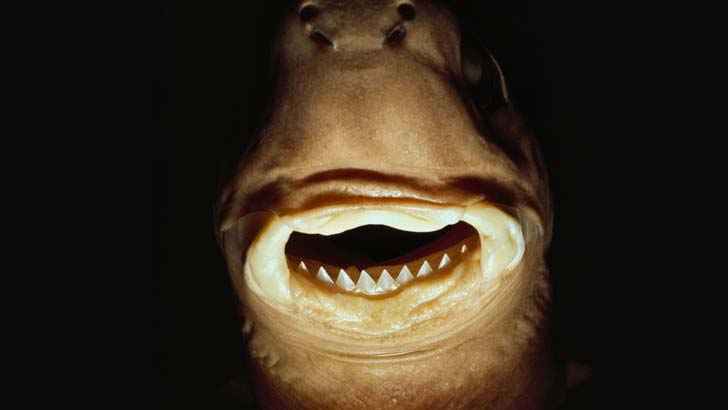 The name “cookiecutter shark” refers to its feeding habit of gouging round plugs, as if cut out with a cookie cutter, out of larger animals. Marks made by cookiecutter sharks have been found on a wide variety of marine mammals and fishes, as well as on submarines, undersea cables, and even human bodies.
The name “cookiecutter shark” refers to its feeding habit of gouging round plugs, as if cut out with a cookie cutter, out of larger animals. Marks made by cookiecutter sharks have been found on a wide variety of marine mammals and fishes, as well as on submarines, undersea cables, and even human bodies.
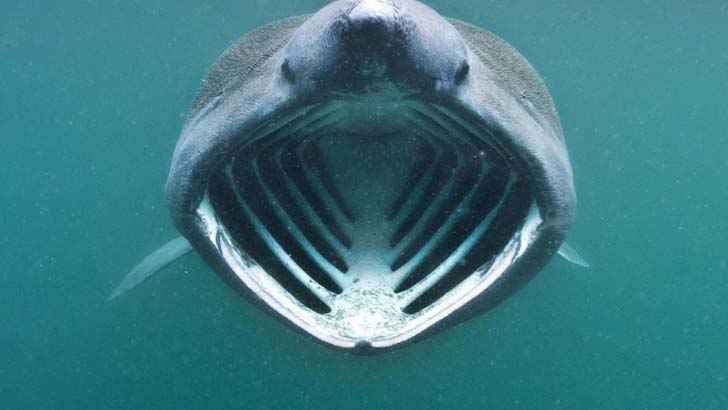 The basking shark is a migratory species, found in all the world’s temperate oceans. A slow-moving filter feeder, its common name derives from its habit of feeding at the surface, appearing to be basking in the warmer water there. It has adaptations for filter feeding, such as a greatly enlarged mouth and highly developed gill rakers.
The basking shark is a migratory species, found in all the world’s temperate oceans. A slow-moving filter feeder, its common name derives from its habit of feeding at the surface, appearing to be basking in the warmer water there. It has adaptations for filter feeding, such as a greatly enlarged mouth and highly developed gill rakers.
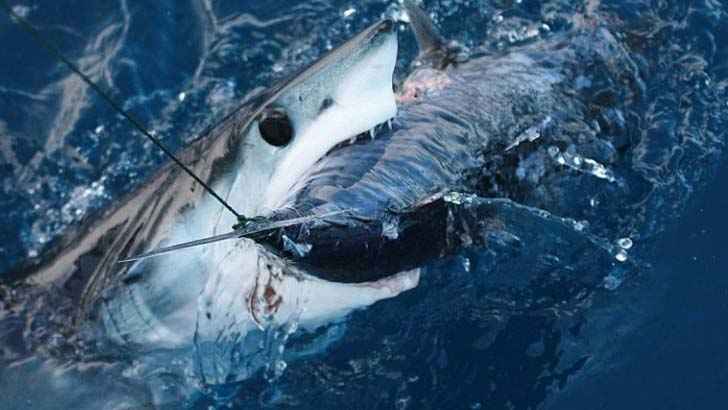 Mako sharks are capable of swimming at speeds up to 37 mph, and jumping up to 23 ft into the air. The great white shark is also closely related to an ancient Mako shark.
Mako sharks are capable of swimming at speeds up to 37 mph, and jumping up to 23 ft into the air. The great white shark is also closely related to an ancient Mako shark.
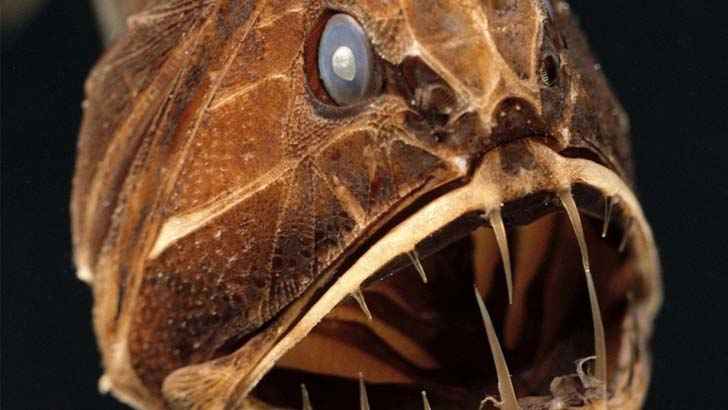 The pelagic Fangtooths are among the deepest-living fish, found as far as 16,000 ft down. They may undergo diel migrations as is common with many deep-sea fish. By day these fish remain in the gloomy depths and towards evening they rise to the upper layers of the water to feed by starlight.
The pelagic Fangtooths are among the deepest-living fish, found as far as 16,000 ft down. They may undergo diel migrations as is common with many deep-sea fish. By day these fish remain in the gloomy depths and towards evening they rise to the upper layers of the water to feed by starlight.
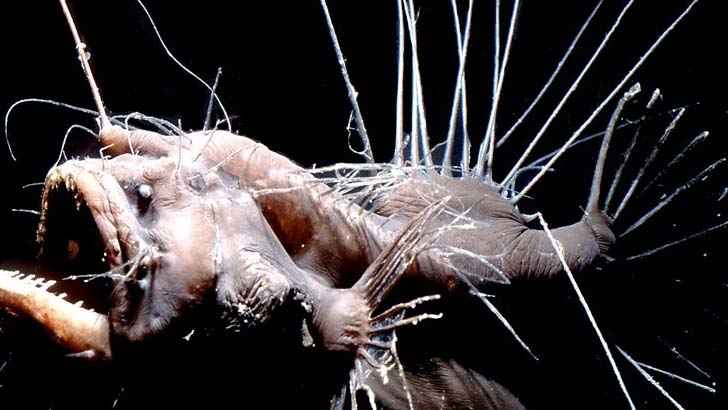 Black sea devils are characterized by a gelatinous, mostly scaleless body, a large head, and generous complement of menacingly large, sharp, glassy, fang-like teeth lining the jaws of a cavernous, oblique mouth. Sea Devils have attached to their head an Illicium and Esca. The Illicium acts as a fishing rod, and the Esca is the lure.The Esca glows due to bioluminescence that is produced by symbiotic bacteria.
Black sea devils are characterized by a gelatinous, mostly scaleless body, a large head, and generous complement of menacingly large, sharp, glassy, fang-like teeth lining the jaws of a cavernous, oblique mouth. Sea Devils have attached to their head an Illicium and Esca. The Illicium acts as a fishing rod, and the Esca is the lure.The Esca glows due to bioluminescence that is produced by symbiotic bacteria.
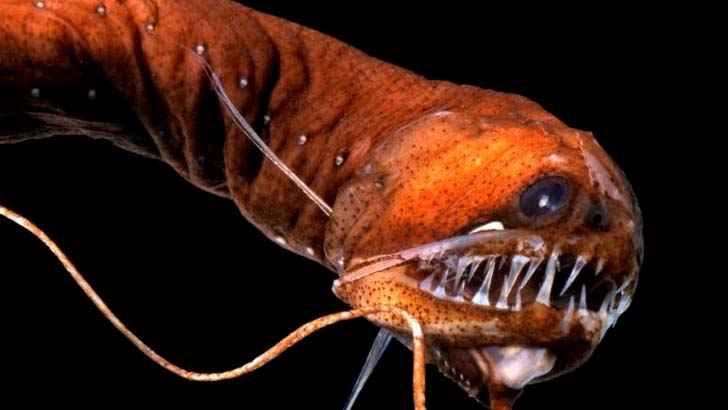 The dragonfish, Grammatostomias flagellibarba, is a deep sea creature that lurks around the Atlantic seaboard of North America and Africa. These creatures are known for the luminescent barbel that they develop, allowing them to create light which attracts their prey to them.
The dragonfish, Grammatostomias flagellibarba, is a deep sea creature that lurks around the Atlantic seaboard of North America and Africa. These creatures are known for the luminescent barbel that they develop, allowing them to create light which attracts their prey to them.
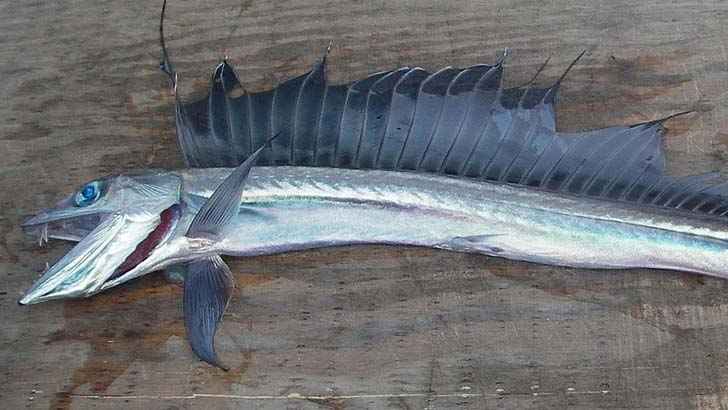 Lancetfish are a large oceanic predatory fish, that possess a long and very high dorsal fin, soft-rayed from end to end, with an adipose fin behind it. The dorsal fin has 41 to 44 rays and occupies the greater length of the back. This fin is rounded in outline, about twice as high as the fish is deep, and can be depressed into a groove along the back.
Lancetfish are a large oceanic predatory fish, that possess a long and very high dorsal fin, soft-rayed from end to end, with an adipose fin behind it. The dorsal fin has 41 to 44 rays and occupies the greater length of the back. This fin is rounded in outline, about twice as high as the fish is deep, and can be depressed into a groove along the back.
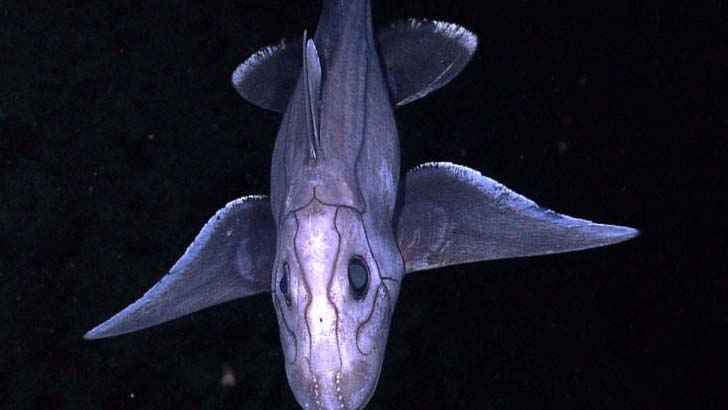 At one time, a “diverse and abundant” group, their closest living relatives are sharks, though in evolutionary terms, they branched off from sharks nearly 400 million years ago and have remained isolated ever since. Today, they are largely confined to deep water. They lack sharks’ many sharp and replaceable teeth, having instead three pairs of large permanent grinding tooth plates.
At one time, a “diverse and abundant” group, their closest living relatives are sharks, though in evolutionary terms, they branched off from sharks nearly 400 million years ago and have remained isolated ever since. Today, they are largely confined to deep water. They lack sharks’ many sharp and replaceable teeth, having instead three pairs of large permanent grinding tooth plates.
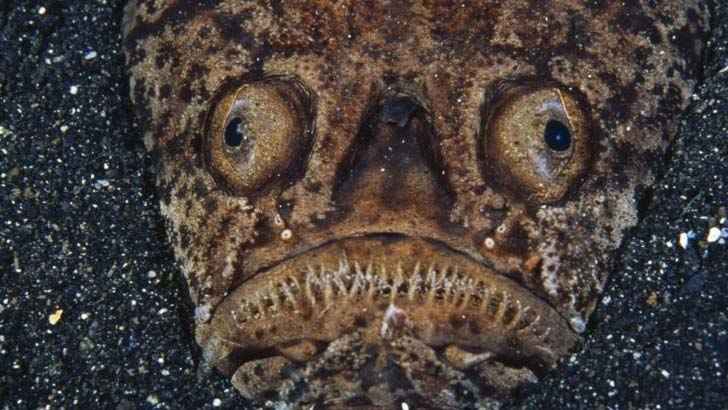 In addition to the top-mounted eyes, a stargazer also has a large, upward-facing mouth in a large head. Their usual habit is to bury themselves in sand, and leap upwards to ambush prey that passes overhead. Stargazers are venomous, they have two large spines situated behind their opercles and above their pectoral fins.
In addition to the top-mounted eyes, a stargazer also has a large, upward-facing mouth in a large head. Their usual habit is to bury themselves in sand, and leap upwards to ambush prey that passes overhead. Stargazers are venomous, they have two large spines situated behind their opercles and above their pectoral fins.
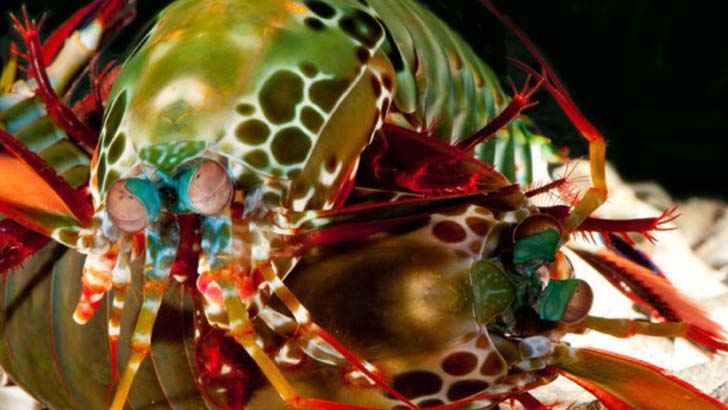 Called “sea locusts” by ancient Assyrians, “prawn killers” in Australia and now sometimes referred to as “thumb splitters” because of the animal’s ability to inflict painful gashes if handled without caution, mantis shrimps sport powerful claws that are used to attack and kill prey by spearing, stunning, or dismembering. In captivity, some larger species can break through aquarium glass with a single strike.
Called “sea locusts” by ancient Assyrians, “prawn killers” in Australia and now sometimes referred to as “thumb splitters” because of the animal’s ability to inflict painful gashes if handled without caution, mantis shrimps sport powerful claws that are used to attack and kill prey by spearing, stunning, or dismembering. In captivity, some larger species can break through aquarium glass with a single strike.
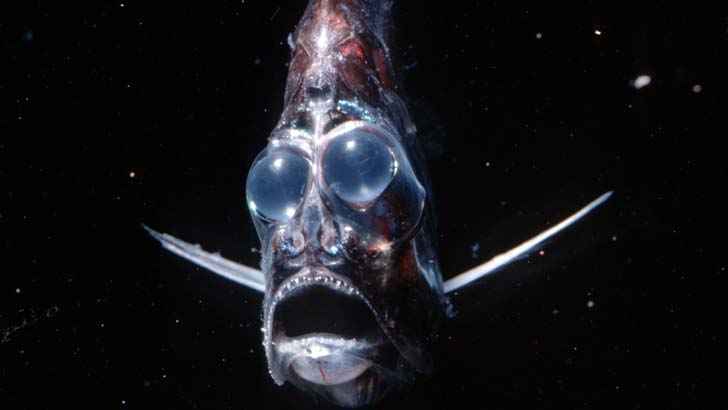 Marine Hatchetfish are small deep-sea fishes which have evolved a peculiar body shape, the shape of a hatchet. Their bioluminescent photophores allow them to use counter-illumination to escape predators that lurk in the depths, by matching the light intensity with the light penetrating the water from above, the fish does not appear darker if seen from below.
Marine Hatchetfish are small deep-sea fishes which have evolved a peculiar body shape, the shape of a hatchet. Their bioluminescent photophores allow them to use counter-illumination to escape predators that lurk in the depths, by matching the light intensity with the light penetrating the water from above, the fish does not appear darker if seen from below.
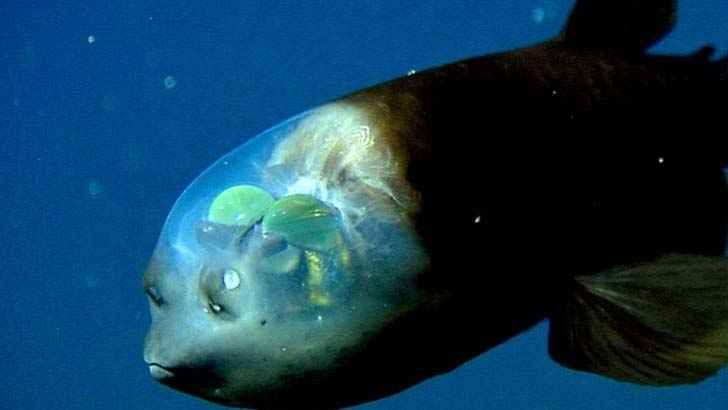 These fish are named because of their barrel-shaped, tubular eyes, which are generally directed upwards to detect the silhouettes of available prey. All species have large, telescoping eyes, which dominate and protrude from the head, but are enclosed within a large transparent dome of soft tissue. The transparent dome apparently serves the purpose of collecting additional incident light.
These fish are named because of their barrel-shaped, tubular eyes, which are generally directed upwards to detect the silhouettes of available prey. All species have large, telescoping eyes, which dominate and protrude from the head, but are enclosed within a large transparent dome of soft tissue. The transparent dome apparently serves the purpose of collecting additional incident light.
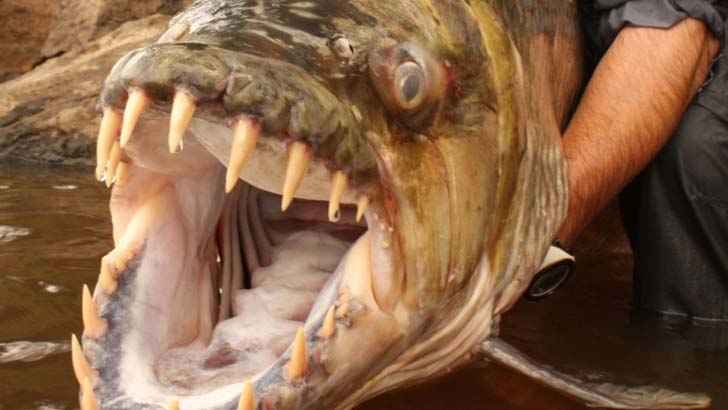 These elongated, predatory fish are distinguished by their long dorsal fins, large mouths, and shiny teeth. They breathe air with gills, which allows them to migrate short distances over land. Snakeheads can become invasive species and cause ecological damage because in many areas to which they are not native the absence of natural enemies gives them top-level predator status. Not only can they breathe air, but they can also survive on land for up to four days, provided they are wet, and are known to migrate up to 1/4 mile on wet land to other bodies of water by wriggling with their body and fins.
These elongated, predatory fish are distinguished by their long dorsal fins, large mouths, and shiny teeth. They breathe air with gills, which allows them to migrate short distances over land. Snakeheads can become invasive species and cause ecological damage because in many areas to which they are not native the absence of natural enemies gives them top-level predator status. Not only can they breathe air, but they can also survive on land for up to four days, provided they are wet, and are known to migrate up to 1/4 mile on wet land to other bodies of water by wriggling with their body and fins.
 The animal has strongly reduced eyes that lack pigment, and is thought to be blind. The hairy pincers contain filamentous bacteria, which the creature may use to detoxify poisonous minerals from the water emitted by the hydrothermal vents where it lives. This process is known as chemosynthesis. Alternatively, it may feed on bacteria, although it is generally thought to be a carnivore.
The animal has strongly reduced eyes that lack pigment, and is thought to be blind. The hairy pincers contain filamentous bacteria, which the creature may use to detoxify poisonous minerals from the water emitted by the hydrothermal vents where it lives. This process is known as chemosynthesis. Alternatively, it may feed on bacteria, although it is generally thought to be a carnivore.
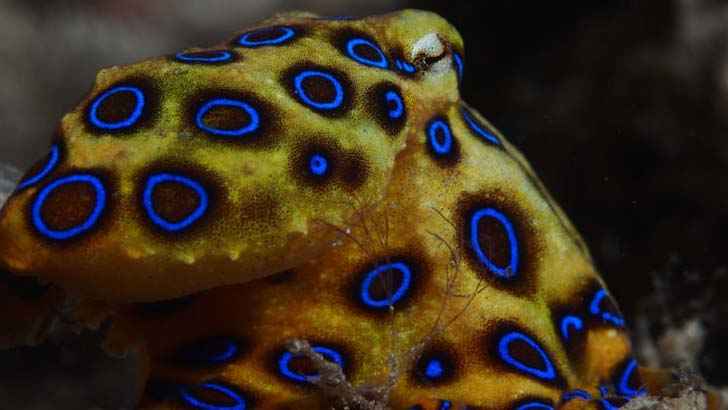 The Blue Ringed Octopus can be identified by their characteristic blue and black rings, and yellowish skin. When the octopus is agitated, the brown patches darken dramatically, iridescent blue rings, or clumps of rings, appear and pulsate. The octopus produces venom that can result in nausea, respiratory arrest, heart failure, severe and sometimes total paralysis, blindness, and can lead to death within minutes if not treated.
The Blue Ringed Octopus can be identified by their characteristic blue and black rings, and yellowish skin. When the octopus is agitated, the brown patches darken dramatically, iridescent blue rings, or clumps of rings, appear and pulsate. The octopus produces venom that can result in nausea, respiratory arrest, heart failure, severe and sometimes total paralysis, blindness, and can lead to death within minutes if not treated.
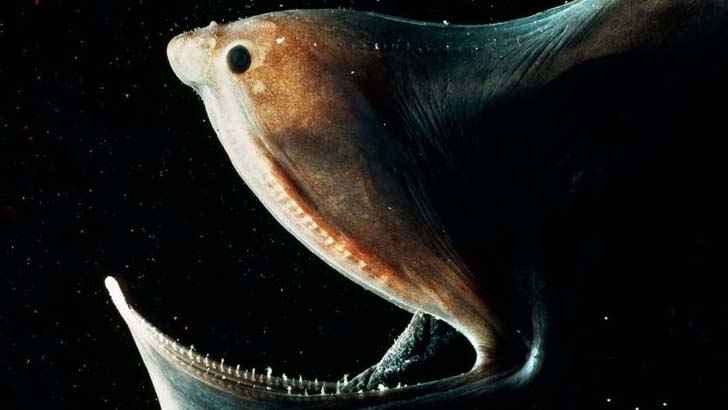 Gulper Eel jaws are quite large, lined with small teeth, and several types are notable for being able to consume fish larger than themselves. These creatures were first found by deep sea fishermen’s nets. Extensive research has not been conducted on them due to being indirectly observed. They can live as deep as 10,000 ft. down in the ocean, well into the aphotic zone.
Gulper Eel jaws are quite large, lined with small teeth, and several types are notable for being able to consume fish larger than themselves. These creatures were first found by deep sea fishermen’s nets. Extensive research has not been conducted on them due to being indirectly observed. They can live as deep as 10,000 ft. down in the ocean, well into the aphotic zone.
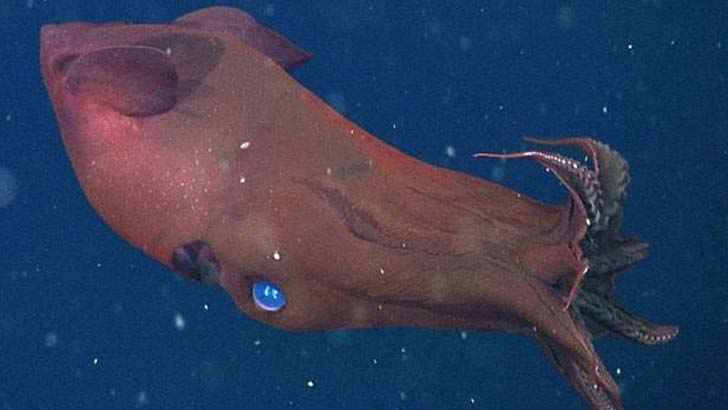 The vampire squid is almost entirely covered in light-producing organs called photophores, capable of producing disorienting flashes of light ranging in duration from fractions of a second to several minutes. The intensity and size of the photophores can also be modulated. If disturbed or threatened, the Vampire Squid will curl its arms up outwards and wrap them around its body, turning itself inside-out in a way, exposing spiny projections.
The vampire squid is almost entirely covered in light-producing organs called photophores, capable of producing disorienting flashes of light ranging in duration from fractions of a second to several minutes. The intensity and size of the photophores can also be modulated. If disturbed or threatened, the Vampire Squid will curl its arms up outwards and wrap them around its body, turning itself inside-out in a way, exposing spiny projections.
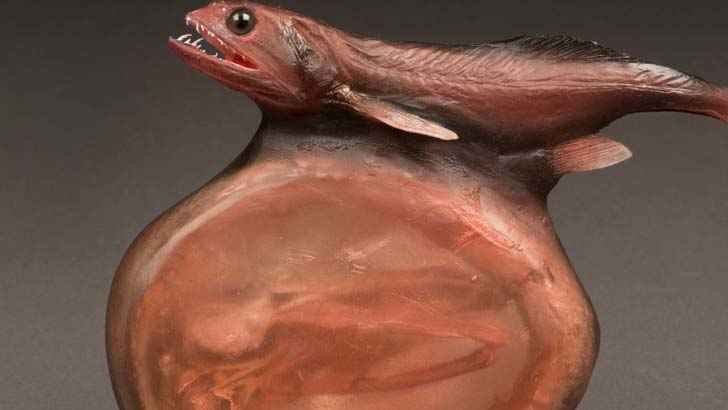 The black swallower feeds on bony fishes, which are swallowed whole. With its greatly distensible stomach, it is capable of swallowing prey over twice its length and 10 times its mass. Its upper jaws are articulated with the skull at the front via the suspensorium, which allows the jaws to swing down and encompass objects larger than the swallower’s head.
The black swallower feeds on bony fishes, which are swallowed whole. With its greatly distensible stomach, it is capable of swallowing prey over twice its length and 10 times its mass. Its upper jaws are articulated with the skull at the front via the suspensorium, which allows the jaws to swing down and encompass objects larger than the swallower’s head.
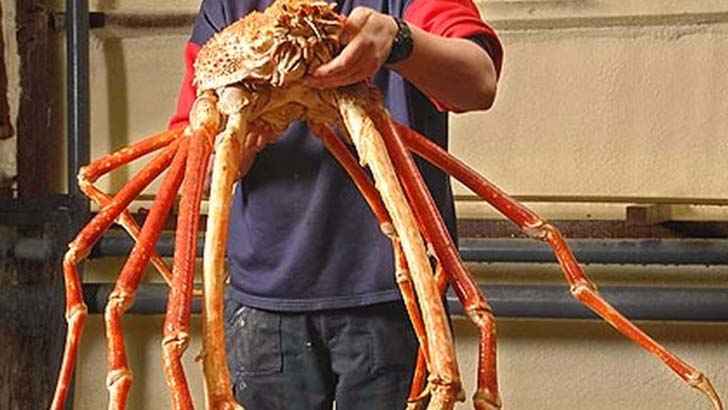 The Japanese spider crab has the greatest leg span of any arthropod, reaching 18 ft. from claw to claw. The Japanese name for this species is taka-ashi-gani translating to “tall legs crab.” Their armored exoskeletons help protect them from larger predators such as octopuses, but giant spider crabs also use camouflage. The crab’s bumpy carapace blends into the rocky ocean floor. To further the illusion, a spider crab will adorn its shell with sponges and other animals.
The Japanese spider crab has the greatest leg span of any arthropod, reaching 18 ft. from claw to claw. The Japanese name for this species is taka-ashi-gani translating to “tall legs crab.” Their armored exoskeletons help protect them from larger predators such as octopuses, but giant spider crabs also use camouflage. The crab’s bumpy carapace blends into the rocky ocean floor. To further the illusion, a spider crab will adorn its shell with sponges and other animals.
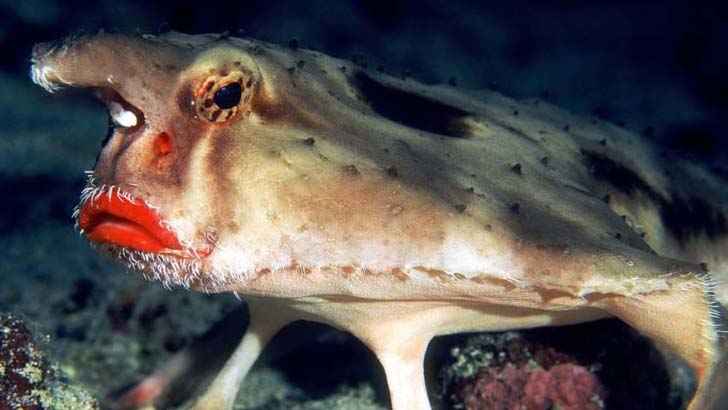 This fish is mainly known for its bright red lips. Batfish are not particularly good swimmers, they use their pectoral fins to walk on the ocean floor. When the Batfish reaches maturity, its dorsal fin becomes a single spine-like projection, believed to function primarily as a lure for catching prey.
This fish is mainly known for its bright red lips. Batfish are not particularly good swimmers, they use their pectoral fins to walk on the ocean floor. When the Batfish reaches maturity, its dorsal fin becomes a single spine-like projection, believed to function primarily as a lure for catching prey.
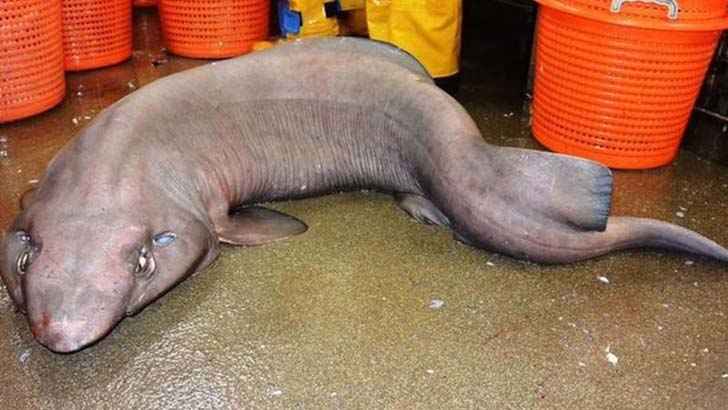 The False Catshark has a broad head with a short, rounded snout. The nostrils have large flaps of skin on their anterior rims. The narrow eyes are over twice as long as they are high. This creature’s huge mouth is arched and bears short furrows at the corners. There are over two hundred rows of tiny teeth in each jaw, arranged in straight lines in the upper jaw and diagonal lines in the lower jaw.
The False Catshark has a broad head with a short, rounded snout. The nostrils have large flaps of skin on their anterior rims. The narrow eyes are over twice as long as they are high. This creature’s huge mouth is arched and bears short furrows at the corners. There are over two hundred rows of tiny teeth in each jaw, arranged in straight lines in the upper jaw and diagonal lines in the lower jaw.
 Predatory fish with razor sharp teeth, poisonous squid that emit brilliant colors, and massive whales that can weigh more than 40,000 lbs, just to name a few. Read ahead to see what really lurks beneath.
Predatory fish with razor sharp teeth, poisonous squid that emit brilliant colors, and massive whales that can weigh more than 40,000 lbs, just to name a few. Read ahead to see what really lurks beneath.
Wolf Fish
 Apart from their iconic appearance, Wolf Fish are unique for the natural antifreeze they produce to keep their blood moving regularly in their very cold habitat. Wolf Fish are an important factor in controlling green crab and sea urchin populations, which can become overly disruptive to habitats if left unchecked.
Apart from their iconic appearance, Wolf Fish are unique for the natural antifreeze they produce to keep their blood moving regularly in their very cold habitat. Wolf Fish are an important factor in controlling green crab and sea urchin populations, which can become overly disruptive to habitats if left unchecked.
Goblin Shark
 The goblin shark is a rare species of deep-sea shark. Sometimes called a “living fossil”, it is the only extant representative of the family Mitsukurinidae, a species figured to be 125 million years old. This light skinned animal has a distinctive profile with an elongated, flattened snout, and highly protrusible jaws containing prominent nail-like teeth.
The goblin shark is a rare species of deep-sea shark. Sometimes called a “living fossil”, it is the only extant representative of the family Mitsukurinidae, a species figured to be 125 million years old. This light skinned animal has a distinctive profile with an elongated, flattened snout, and highly protrusible jaws containing prominent nail-like teeth.
Colossal Squid
 The colossal squid, sometimes called the Antarctic or giant cranch squid, is believed to be the largest squid species. The colossal squid’s limbs are also equipped with sharp hooks, some swivelling, others three-pointed.
The colossal squid, sometimes called the Antarctic or giant cranch squid, is believed to be the largest squid species. The colossal squid’s limbs are also equipped with sharp hooks, some swivelling, others three-pointed.
Beluga Whale
 The beluga whale or white whale is an Arctic and sub-Arctic species. This marine mammal is commonly referred to as the sea canary due to its high-pitched twitter. Belugas are gregarious and form groups of up to 10 animals on average, although during the summer, they can gather in the hundreds or even thousands in estuaries and shallow coastal areas.
The beluga whale or white whale is an Arctic and sub-Arctic species. This marine mammal is commonly referred to as the sea canary due to its high-pitched twitter. Belugas are gregarious and form groups of up to 10 animals on average, although during the summer, they can gather in the hundreds or even thousands in estuaries and shallow coastal areas.
Frilled Shark
 The frilled shark captures its prey by bending its body and lunging forward like a snake. The long, extremely flexible jaws enable it to swallow prey whole, while its many rows of small, needle-like teeth make it near impossible for the prey to escape.
The frilled shark captures its prey by bending its body and lunging forward like a snake. The long, extremely flexible jaws enable it to swallow prey whole, while its many rows of small, needle-like teeth make it near impossible for the prey to escape.
Giant Manta Ray
 The giant oceanic manta ray can grow to a disc size of up to 23 ft with a weight of about 2,980lbs but average size commonly observed is 15 ft. It is dorsoventrally flattened and has large, triangular pectoral fins on either side of the disc.
The giant oceanic manta ray can grow to a disc size of up to 23 ft with a weight of about 2,980lbs but average size commonly observed is 15 ft. It is dorsoventrally flattened and has large, triangular pectoral fins on either side of the disc.
Blobfish
 Due to its low-density flesh, the blobfish’s appearance is very different when it is out of water. Its strange and unappealing looks have created much discussion in media outlets. Scientists now fear the blobfish could soon become an endangered species because of deep-ocean trawling.
Due to its low-density flesh, the blobfish’s appearance is very different when it is out of water. Its strange and unappealing looks have created much discussion in media outlets. Scientists now fear the blobfish could soon become an endangered species because of deep-ocean trawling.
The Whale Shark
 The whale shark is a slow-moving carpet shark and the largest known fish species. The largest confirmed Whale Shark measured in at 41.5 ft and a weight of about 47,000 lbs. Unconfirmed claims of considerably larger Whale Sharks, over 46 ft long and weighing at least 66,000 lbs, are not uncommon.
The whale shark is a slow-moving carpet shark and the largest known fish species. The largest confirmed Whale Shark measured in at 41.5 ft and a weight of about 47,000 lbs. Unconfirmed claims of considerably larger Whale Sharks, over 46 ft long and weighing at least 66,000 lbs, are not uncommon.
Cookie Cutter Shark
 The name “cookiecutter shark” refers to its feeding habit of gouging round plugs, as if cut out with a cookie cutter, out of larger animals. Marks made by cookiecutter sharks have been found on a wide variety of marine mammals and fishes, as well as on submarines, undersea cables, and even human bodies.
The name “cookiecutter shark” refers to its feeding habit of gouging round plugs, as if cut out with a cookie cutter, out of larger animals. Marks made by cookiecutter sharks have been found on a wide variety of marine mammals and fishes, as well as on submarines, undersea cables, and even human bodies.
Basking Shark
 The basking shark is a migratory species, found in all the world’s temperate oceans. A slow-moving filter feeder, its common name derives from its habit of feeding at the surface, appearing to be basking in the warmer water there. It has adaptations for filter feeding, such as a greatly enlarged mouth and highly developed gill rakers.
The basking shark is a migratory species, found in all the world’s temperate oceans. A slow-moving filter feeder, its common name derives from its habit of feeding at the surface, appearing to be basking in the warmer water there. It has adaptations for filter feeding, such as a greatly enlarged mouth and highly developed gill rakers.
Mako Shark
 Mako sharks are capable of swimming at speeds up to 37 mph, and jumping up to 23 ft into the air. The great white shark is also closely related to an ancient Mako shark.
Mako sharks are capable of swimming at speeds up to 37 mph, and jumping up to 23 ft into the air. The great white shark is also closely related to an ancient Mako shark.
Fangtooth
 The pelagic Fangtooths are among the deepest-living fish, found as far as 16,000 ft down. They may undergo diel migrations as is common with many deep-sea fish. By day these fish remain in the gloomy depths and towards evening they rise to the upper layers of the water to feed by starlight.
The pelagic Fangtooths are among the deepest-living fish, found as far as 16,000 ft down. They may undergo diel migrations as is common with many deep-sea fish. By day these fish remain in the gloomy depths and towards evening they rise to the upper layers of the water to feed by starlight.
Black Seadevil
 Black sea devils are characterized by a gelatinous, mostly scaleless body, a large head, and generous complement of menacingly large, sharp, glassy, fang-like teeth lining the jaws of a cavernous, oblique mouth. Sea Devils have attached to their head an Illicium and Esca. The Illicium acts as a fishing rod, and the Esca is the lure.The Esca glows due to bioluminescence that is produced by symbiotic bacteria.
Black sea devils are characterized by a gelatinous, mostly scaleless body, a large head, and generous complement of menacingly large, sharp, glassy, fang-like teeth lining the jaws of a cavernous, oblique mouth. Sea Devils have attached to their head an Illicium and Esca. The Illicium acts as a fishing rod, and the Esca is the lure.The Esca glows due to bioluminescence that is produced by symbiotic bacteria.
Dragonfish
 The dragonfish, Grammatostomias flagellibarba, is a deep sea creature that lurks around the Atlantic seaboard of North America and Africa. These creatures are known for the luminescent barbel that they develop, allowing them to create light which attracts their prey to them.
The dragonfish, Grammatostomias flagellibarba, is a deep sea creature that lurks around the Atlantic seaboard of North America and Africa. These creatures are known for the luminescent barbel that they develop, allowing them to create light which attracts their prey to them.
Lancetfish
 Lancetfish are a large oceanic predatory fish, that possess a long and very high dorsal fin, soft-rayed from end to end, with an adipose fin behind it. The dorsal fin has 41 to 44 rays and occupies the greater length of the back. This fin is rounded in outline, about twice as high as the fish is deep, and can be depressed into a groove along the back.
Lancetfish are a large oceanic predatory fish, that possess a long and very high dorsal fin, soft-rayed from end to end, with an adipose fin behind it. The dorsal fin has 41 to 44 rays and occupies the greater length of the back. This fin is rounded in outline, about twice as high as the fish is deep, and can be depressed into a groove along the back.
Ghost Shark
 At one time, a “diverse and abundant” group, their closest living relatives are sharks, though in evolutionary terms, they branched off from sharks nearly 400 million years ago and have remained isolated ever since. Today, they are largely confined to deep water. They lack sharks’ many sharp and replaceable teeth, having instead three pairs of large permanent grinding tooth plates.
At one time, a “diverse and abundant” group, their closest living relatives are sharks, though in evolutionary terms, they branched off from sharks nearly 400 million years ago and have remained isolated ever since. Today, they are largely confined to deep water. They lack sharks’ many sharp and replaceable teeth, having instead three pairs of large permanent grinding tooth plates.
Stargazer
 In addition to the top-mounted eyes, a stargazer also has a large, upward-facing mouth in a large head. Their usual habit is to bury themselves in sand, and leap upwards to ambush prey that passes overhead. Stargazers are venomous, they have two large spines situated behind their opercles and above their pectoral fins.
In addition to the top-mounted eyes, a stargazer also has a large, upward-facing mouth in a large head. Their usual habit is to bury themselves in sand, and leap upwards to ambush prey that passes overhead. Stargazers are venomous, they have two large spines situated behind their opercles and above their pectoral fins.
Mantis Shrimp
 Called “sea locusts” by ancient Assyrians, “prawn killers” in Australia and now sometimes referred to as “thumb splitters” because of the animal’s ability to inflict painful gashes if handled without caution, mantis shrimps sport powerful claws that are used to attack and kill prey by spearing, stunning, or dismembering. In captivity, some larger species can break through aquarium glass with a single strike.
Called “sea locusts” by ancient Assyrians, “prawn killers” in Australia and now sometimes referred to as “thumb splitters” because of the animal’s ability to inflict painful gashes if handled without caution, mantis shrimps sport powerful claws that are used to attack and kill prey by spearing, stunning, or dismembering. In captivity, some larger species can break through aquarium glass with a single strike.
Hatchetfish
 Marine Hatchetfish are small deep-sea fishes which have evolved a peculiar body shape, the shape of a hatchet. Their bioluminescent photophores allow them to use counter-illumination to escape predators that lurk in the depths, by matching the light intensity with the light penetrating the water from above, the fish does not appear darker if seen from below.
Marine Hatchetfish are small deep-sea fishes which have evolved a peculiar body shape, the shape of a hatchet. Their bioluminescent photophores allow them to use counter-illumination to escape predators that lurk in the depths, by matching the light intensity with the light penetrating the water from above, the fish does not appear darker if seen from below.
Barreleye
 These fish are named because of their barrel-shaped, tubular eyes, which are generally directed upwards to detect the silhouettes of available prey. All species have large, telescoping eyes, which dominate and protrude from the head, but are enclosed within a large transparent dome of soft tissue. The transparent dome apparently serves the purpose of collecting additional incident light.
These fish are named because of their barrel-shaped, tubular eyes, which are generally directed upwards to detect the silhouettes of available prey. All species have large, telescoping eyes, which dominate and protrude from the head, but are enclosed within a large transparent dome of soft tissue. The transparent dome apparently serves the purpose of collecting additional incident light.
Snakehead
 These elongated, predatory fish are distinguished by their long dorsal fins, large mouths, and shiny teeth. They breathe air with gills, which allows them to migrate short distances over land. Snakeheads can become invasive species and cause ecological damage because in many areas to which they are not native the absence of natural enemies gives them top-level predator status. Not only can they breathe air, but they can also survive on land for up to four days, provided they are wet, and are known to migrate up to 1/4 mile on wet land to other bodies of water by wriggling with their body and fins.
These elongated, predatory fish are distinguished by their long dorsal fins, large mouths, and shiny teeth. They breathe air with gills, which allows them to migrate short distances over land. Snakeheads can become invasive species and cause ecological damage because in many areas to which they are not native the absence of natural enemies gives them top-level predator status. Not only can they breathe air, but they can also survive on land for up to four days, provided they are wet, and are known to migrate up to 1/4 mile on wet land to other bodies of water by wriggling with their body and fins.
Kiwa Hirsuta
 The animal has strongly reduced eyes that lack pigment, and is thought to be blind. The hairy pincers contain filamentous bacteria, which the creature may use to detoxify poisonous minerals from the water emitted by the hydrothermal vents where it lives. This process is known as chemosynthesis. Alternatively, it may feed on bacteria, although it is generally thought to be a carnivore.
The animal has strongly reduced eyes that lack pigment, and is thought to be blind. The hairy pincers contain filamentous bacteria, which the creature may use to detoxify poisonous minerals from the water emitted by the hydrothermal vents where it lives. This process is known as chemosynthesis. Alternatively, it may feed on bacteria, although it is generally thought to be a carnivore.
Blue Ringed Octopus
 The Blue Ringed Octopus can be identified by their characteristic blue and black rings, and yellowish skin. When the octopus is agitated, the brown patches darken dramatically, iridescent blue rings, or clumps of rings, appear and pulsate. The octopus produces venom that can result in nausea, respiratory arrest, heart failure, severe and sometimes total paralysis, blindness, and can lead to death within minutes if not treated.
The Blue Ringed Octopus can be identified by their characteristic blue and black rings, and yellowish skin. When the octopus is agitated, the brown patches darken dramatically, iridescent blue rings, or clumps of rings, appear and pulsate. The octopus produces venom that can result in nausea, respiratory arrest, heart failure, severe and sometimes total paralysis, blindness, and can lead to death within minutes if not treated.
Gulper Eel
 Gulper Eel jaws are quite large, lined with small teeth, and several types are notable for being able to consume fish larger than themselves. These creatures were first found by deep sea fishermen’s nets. Extensive research has not been conducted on them due to being indirectly observed. They can live as deep as 10,000 ft. down in the ocean, well into the aphotic zone.
Gulper Eel jaws are quite large, lined with small teeth, and several types are notable for being able to consume fish larger than themselves. These creatures were first found by deep sea fishermen’s nets. Extensive research has not been conducted on them due to being indirectly observed. They can live as deep as 10,000 ft. down in the ocean, well into the aphotic zone.
Vampire Squid
 The vampire squid is almost entirely covered in light-producing organs called photophores, capable of producing disorienting flashes of light ranging in duration from fractions of a second to several minutes. The intensity and size of the photophores can also be modulated. If disturbed or threatened, the Vampire Squid will curl its arms up outwards and wrap them around its body, turning itself inside-out in a way, exposing spiny projections.
The vampire squid is almost entirely covered in light-producing organs called photophores, capable of producing disorienting flashes of light ranging in duration from fractions of a second to several minutes. The intensity and size of the photophores can also be modulated. If disturbed or threatened, the Vampire Squid will curl its arms up outwards and wrap them around its body, turning itself inside-out in a way, exposing spiny projections.
Black Swallower
 The black swallower feeds on bony fishes, which are swallowed whole. With its greatly distensible stomach, it is capable of swallowing prey over twice its length and 10 times its mass. Its upper jaws are articulated with the skull at the front via the suspensorium, which allows the jaws to swing down and encompass objects larger than the swallower’s head.
The black swallower feeds on bony fishes, which are swallowed whole. With its greatly distensible stomach, it is capable of swallowing prey over twice its length and 10 times its mass. Its upper jaws are articulated with the skull at the front via the suspensorium, which allows the jaws to swing down and encompass objects larger than the swallower’s head.
Japanese Spider Crab
 The Japanese spider crab has the greatest leg span of any arthropod, reaching 18 ft. from claw to claw. The Japanese name for this species is taka-ashi-gani translating to “tall legs crab.” Their armored exoskeletons help protect them from larger predators such as octopuses, but giant spider crabs also use camouflage. The crab’s bumpy carapace blends into the rocky ocean floor. To further the illusion, a spider crab will adorn its shell with sponges and other animals.
The Japanese spider crab has the greatest leg span of any arthropod, reaching 18 ft. from claw to claw. The Japanese name for this species is taka-ashi-gani translating to “tall legs crab.” Their armored exoskeletons help protect them from larger predators such as octopuses, but giant spider crabs also use camouflage. The crab’s bumpy carapace blends into the rocky ocean floor. To further the illusion, a spider crab will adorn its shell with sponges and other animals.
Red Lipped Batfish
 This fish is mainly known for its bright red lips. Batfish are not particularly good swimmers, they use their pectoral fins to walk on the ocean floor. When the Batfish reaches maturity, its dorsal fin becomes a single spine-like projection, believed to function primarily as a lure for catching prey.
This fish is mainly known for its bright red lips. Batfish are not particularly good swimmers, they use their pectoral fins to walk on the ocean floor. When the Batfish reaches maturity, its dorsal fin becomes a single spine-like projection, believed to function primarily as a lure for catching prey.
False Catshark
 The False Catshark has a broad head with a short, rounded snout. The nostrils have large flaps of skin on their anterior rims. The narrow eyes are over twice as long as they are high. This creature’s huge mouth is arched and bears short furrows at the corners. There are over two hundred rows of tiny teeth in each jaw, arranged in straight lines in the upper jaw and diagonal lines in the lower jaw.
The False Catshark has a broad head with a short, rounded snout. The nostrils have large flaps of skin on their anterior rims. The narrow eyes are over twice as long as they are high. This creature’s huge mouth is arched and bears short furrows at the corners. There are over two hundred rows of tiny teeth in each jaw, arranged in straight lines in the upper jaw and diagonal lines in the lower jaw.
More Movies + TV Shows
-


Iconic NBA Stars And Their Exquisite Wives
-


Life-Size “World of Barbie” Exhibit Coming to North America this…
-


Hidden Meanings in Brand Logos
-


Hidden Car Features You Didn’t Know Existed
-


Aging Home Decor Trends You Need To Ditch
-


Ranking The NBA’s Best Point Guards Of All Time
-


Unedited Historical Photos From The Past
-


The Most Breathtaking Sights Around The World
-


POV from the Met Gala barricade, If you’ve ever wanted…
-


John Legend Starts Vegas Residency with Wife Chrissy Teigen and…
-


Artists Who Dislike Their Hit Songs
-


Prince Harry Takes a Tumble Off His Horse as He…

